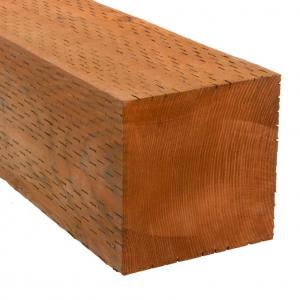
Pressure treated, preserved wood, or treated wood waste (including the sawdust), referred to as TWW, has preserving chemicals like arsenic, chromium, copper, creosote, and pentachlorophenol which are carcinogenic (toxic) and has tell-tale indentations. These chemicals help protect the wood from insect attack and fungal decay while it’s being used. Fence posts, sill plates, landscape timbers, pilings, gazebos, retaining walls, guardrails, decking, agricultural stakes, and railroad ties are some examples. TWW does not include wood painted with "copper green."
Painted, engineered, stained, lacquered, plywood/composite wood may go in the garbage.
What are some things to look for when determining if wood is treated or not?
- Wood manufacturer stamp codes
- Indentations or incising marks on the surface of the wood (as seen in the photo)
- When cut, staining is visible around the perimeter only
- Discoloration with outdoor use (e.g. green or dark brown appearance)
- Interior rot with a solid outer shell
- Visible color penetration just under the edge surface of the wood where it is cut
- Odor
- Treated wood may have an end tag that looks like the figure below.

What doesn’t qualify as treated wood?
- Natural wood with no chemical preservatives.
- Natural wood that is painted or has a surface finish such as lacquer, shellac, polyurethane and varnish.
Disposal and FAQ information links:
- Requirements for Generators and Handlers of Treated Wood Waste
- List of Transfer Stations approved to handle TWW
- List of Landfills approved by the Waterboard to accept TWW
- Safety & Proper Disposal Fact Sheets & Outreach Materials from TWWDisposal.org
TWW is prohibited from being burned, chipped, ground, or mulched.
Households typically generate TWW when a fence or deck is replaced.
- Do not burn the treated wood waste, including sawdust.
- Do not remove or destroy any marking identifying the wood as treated wood.
- Keep TWW segregated from other materials.
- Transport TWW to an authorized TWW facility.
- Identify TWW to TWW facility personnel.
Contractors, Businesses, Haulers, Generators and Landfills Find guidance by user at Treated Wood Waste Disposal.
Wood Preservers & Distributors Companies that pressure treat wood products sold in California have a responsibility to inform wholesalers and retailers on the safe handling and proper disposal of treated wood.

